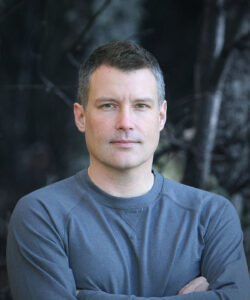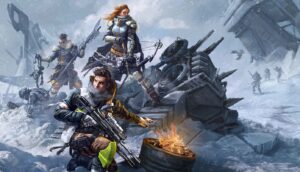
Scavengers is the debut title from Midwinter Entertainment, a Seattle-based developer led by former Halo franchise creative director and 343 Industries studio lead, Josh Holmes.
It’s that pedigree that has attracted a lot of attention for Midwinter’s first title, which is currently in closed beta, and set to release on PC this year.
Early impressions of the game itself have been strong, and it’s an ambitious title for a studio’s first release. Scavengers is a free-to-play, PvEvP, multiplayer, team shooter, focused around survival. Which is… a lot of descriptors.
Essentially, the player will be stepping onto a frozen Earth, chilled by a cataclysmic event when an asteroid shattered the moon and plunged the Earth into an eternal winter. To make matters worse, a mutant-creating virus has spread among the population. This leaves the remaining humans competing to regain control of the planet and hunt for a cure.
Fierce competition for survival is also a feature of such live service games – one that puts Scavengers in competition with some of the biggest names in the business. To find out how the title plans to stand out against the competition, we sat down with Holmes, now CEO and co-founder of Midwinter Entertainment.
What was the original inspiration behind Scavengers? With the hand-drawn promo art it has a pen-and-paper RPG feel about it?
It’s funny because as a team we often reference board games as a model, providing strategic depth, particularly as we discuss the design of our game mode and the dynamic nature of the choices we offer players with scoring objectives across our map. However, the inspiration for the game comes from a number of different sources and people from across the studio. We’re lucky at Midwinter to have a diverse team with a variety of experiences from across the games industry. Whether a person is a veteran game developer or a graduate fresh out of college, they each bring a unique perspective and a range of different influences that have helped shape Scavengers.
For me personally, I have spent a lot of time absorbing dystopian, post-apocalyptic science fiction. Whether it’s John Carpenter’s The Thing, Hugh Howey’s Wool Trilogy, Annihilation, The Road, even films like The Hunger Games and Hanna when it comes to our Explorer characters. Post-apocalyptic sci-fi is a deep well to draw from, and my hope is that we’re able to contribute our own unique perspective that resonates with people once the game releases.
The game has obvious battle royale tropes but it’s more than that, right?

It is. Some players have categorized us as a ‘battle royale’ and it’s understandable, given that we share some familiar elements with that specific type of game experience – small squads descending into a large map to compete, a closing storm that pushes players together, scavenging for weapons and equipment.
However, we never set out to make a Battle Royale game, instead, we looked at where we could push and expand online competitive multiplayer in new and exciting ways.
If you play Scavengers, you’ll see that a huge focus for players is on PvE and completing objectives, with the emphasis not on wiping out other teams and players to secure victory but to strategically explore and conquer the challenges across a vast frozen wasteland.
Players are tasked with securing the most datapoints before they extract from the planet to secure victory. If played a certain way, it’s entirely possible for a squad of players to extract and score a win without engaging in any PvP combat whatsoever. However, we do balance PvE and PvP in such a way that both offer their own strategic value, and require degrees of skill to fully master. Ultimately, for us as a team, one of the most exciting things is how different it feels to anything else we’ve played, or worked on, before.
The studio was acquired by Improbable in 2019. How has that changed your working relationship with the company and the platform?
We’ve had a close relationship with Improbable since we began working together on Scavengers in 2018. At that time we chose to leverage SpatialOS to realize our vision for the game, achieving a large scale PvEvP experience with high player count and hundreds of active AI. Since the acquisition we’ve deepened our technological partnership at the platform level, whilst also benefiting from our relationship with other game studios across the company and around the world. The amount of support that we’ve received has been incredible.
The GaaS model often vacillates between monstrous success and disappearing without a trace, how do you plan to build interest pre-launch and sustain it post-launch?
From the very beginning, we’ve taken a community-first approach to the development of Scavengers. We don’t exist in a vacuum; for over a year we’ve been playtesting with a community of thousands whose feedback has allowed us to shape and evolve the direction of the experience.
It’s been hugely rewarding for us as a team to have that type of interaction with our community, which is why Closed Beta represents such an important milestone in our development. We often think of our community as an extension of the development team, and we’ll continue to expand and actively involve them in our plans through the coming months during the game’s continued development.
Genuine PvEvP shooters are still a rarity, what are the benefits and pitfalls of mixing enemy PCs and NPCs in the same live environment?
 For us it was about offering the player a level of agency and strategic depth that goes beyond just hunting down a target on the map. There exists a balance between objectives, survival systems, deadly weather that pushes across the map, unpredictable wildlife, and roaming bosses – all whilst delivering satisfying gunplay in both a PvE and PvP environment.
For us it was about offering the player a level of agency and strategic depth that goes beyond just hunting down a target on the map. There exists a balance between objectives, survival systems, deadly weather that pushes across the map, unpredictable wildlife, and roaming bosses – all whilst delivering satisfying gunplay in both a PvE and PvP environment.
The opportunity is to explore new ground in the competitive multiplayer space with an experience that offers many avenues to success. There are many challenges, beginning with the fact that there isn’t an existing model for the type of experience we’re creating. Finding the sweet spot between cooperative PvE and competitive PvP has required constant iteration, and we’re still refining that balance. There’s also a degree of technical complexity because you are managing so many moving parts, at such a large scale.
Are you concerned about this being a hyper-competitive market? What would you say is Scavenger’s unique selling point in this market?
We’ve not really been too concerned about the wider market. Scavengers takes a unique approach to competitive multiplayer by embracing PvEvP. We’re a survival shooter set on a vast strategic battleground. The goal is survival, not elimination.
Our hope that our vision for a different type of competitive multiplayer experience resonates with gamers. And we’ve been encouraged over the past year by the fantastic variety of gaming experiences that manifested seemingly from nowhere to become hugely popular – a testament to the power of great ideas and captivating gameplay.
How have playtests been so far? How are you balancing what players tell you, with what you see in the data?
Playtests have been incredible for creating a bridge between our community and the development team. We’ve been running intermittent playtests over the past year, and we’ve received an overwhelming amount of feedback that has been vital in shaping the direction of the game during development.
But to your point, there is always a balance. We look closely at player behaviour; interactions both on the macro and micro levels, to really get to the root of what motivates and compels players through a match.
It can lead to simple tweaks such as AI density or loot drops, or scale up to more sweeping adjustments, such as outpost placements, or how our endgame plays out. Ultimately, each bit of feedback or data is its own puzzle piece that together creates an elaborate picture of the player experience.
It’s rare to see such anticipation for a studio’s first game. How are you making sure you manage expectations, given the Halo legacy at the studio?

It’s always hugely gratifying to see players respond positively to a project you’re working on, especially when it’s been the combined passion of an entire team working on it for a number of years.
We’re a pretty small studio, and we tend to digest feedback and response from players together. We’re constantly sharing observations from the community with one another on our Slack and Discord channels.
We really appreciate the diversity of perspectives we see represented in the feedback we’ve received, especially when it causes us to revisit our own assumptions about a particular part of the experience.
The game has a lot of elements and considerations – How do you ensure it’s accessible to first-time players?
The game offers a lot of depth and different strategic options for players to employ as they pursue their objectives and fight to survive.
We think a lot about the first-time user experience. There is a lot to take in and it’s important that we don’t overwhelm the player with a mass of information and systems immediately.
Each match can be broken down into three main phases, which are ‘Scavenge’, ‘Hunt’, and ‘Extract’. Once you understand the core principles of the match, all of the other components and features fold organically into that experience.
We don’t necessarily expect a new player to jump in and immediately master all the options available to them, but we do want to make sure that the mission and objectives are understandable and compelling from the moment you get your boots in the snow.
As players familiarize themselves with additional systems and side objectives, they can experiment to discover the best strategies for achieving victory.

 MCV/DEVELOP News, events, research and jobs from the games industry
MCV/DEVELOP News, events, research and jobs from the games industry




